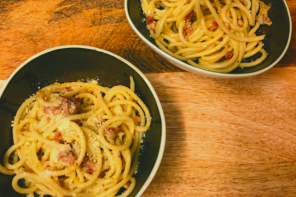With rosé season in full swing, now is an ideal time to take a step back and brush up on your wine knowledge. Explaining why rosé is pink will be your perfect conversation starter all summer long. Since the answer is relatively simple, you can really get a handle on it in time to impress your date tonight, or friends at your pool lounge session this weekend.
Rosé is made from the types of grapes that typically make red wine. The insides of these grapes and the juice that comes out of them are actually white and clear.* It’s the pigment contained in the skins of those grapes that makes our wine red. Over time, as the juice sits on the grape skins it absorbs these pigments (and becomes red itself).
Rosé is pink because the juice sits on these grape skins, but not for nearly as long. The grapes are sorted and macerated (soaked) for a short amount of time. That means that only some of those pigments will be absorbed, and just a bit of the color stays in the juice. Then the juice is bled off and fermented into wine. With only a fraction of the pigments found in reds, it ends up pink — et VOILA!
There are a ton of decisions that go into making wine of any kind, but it’s really up to the winemaker to decide how long to leave the juice sitting on the grape skins. The longer the contact with the skins, the more intense the color, the aromatics and lots more minute details about the finished wine.
Individual grapes have their own characteristics, too. A Grenache Rosé will often be bright pink, like a watermelon. A Tempranillo or Pinot Noir rosé is more likely to be pale, salmony pink. This is yet another reason rosé is so much fun. For as many red grapes as exist in the world, there can be a rosé. It boggles the mind, yet also frees it to run away, imagining all the possibilities and styles that can and might exist.
Now you must go forth with your newfound knowledge and drink some rosé. It seems like a monstrous task, but do it you must — if you’re to continue on your path of wine-loving that is. If in a few weeks from now, you find yourself debating the merits of a Cabernet rosé versus a Cinsault rosé… well, don’t say we didn’t warn you, and welcome to the club.
*wine nerds, before you crucify me, I know there ARE a few grapes out there (teinturier grapes!) that have red insides. Alicante Bouchet. Dornfelder. And more. Those are cool, but we’re not talking about them today, okay?









Enjoyed the well written article and learned about rose…..winesnobfl!
wish i had known that this was being recorded down the street from me!
Loved your article, and I did know why rose is pink. I love me some Blackhawk Winery Rose. Blackhawkwinery.com
Thanks for the quick nugget of information. Couple lingering questions.
1) What should rosé be classified as, a white wine or red wine?
2) What types of rosé are made from white wine grapes and what difference in quality/taste is there?
Hey Dole! So nice to hear from you. Rosé generally falls into its own category, neither red nor white. However, since it is made from red grapes, one could make the argument that it should fall under the red category. Furthermore, rosé is not generally made with white grapes, since it is the skin from the red grapes that gives it its pink hue.
There are a few ways to make rose I wish you had explained them in your article.